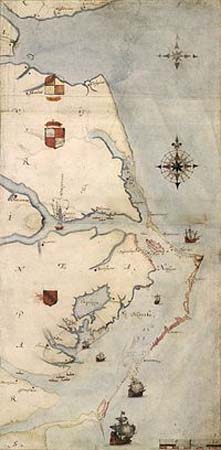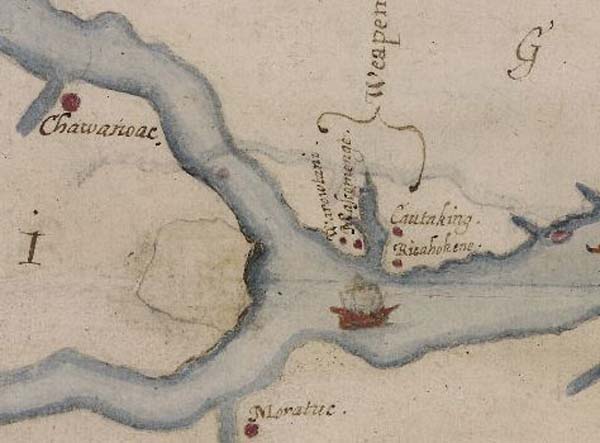Myths of the Lost Colony
The Lost Colony: What We’ve Learned, What We Still Don’t Know
As we approach the 81st year of the outdoor drama “The Lost Colony,” it seems like a good time to reflect back on the mystery of Sir Walter Raleigh’s ill-fated attempt at a colony. Written in 1937, Paul Green’s play script still provides a useful roadmap to guide us through what we know, what we guess, as well as rumors and fact.
We’re not going to look at nuance of the play, just a few points where truth and storytelling both intersect and wander away form each other.
The Colonists Fear of the Spanish
Near the end of the play, with the colony in dire straits, a lookout calls out that he sees a Spanish ship on the horizon. Some of the colonists rejoice wanting to signal the ships, hoping they will be saved.
Others react with near panic until John Borden asserts his authority, notes that the Spanish cannot be trusted and that the colony has to migrate to CROATAN.
There is no way to know if this particular sequence of events actually happened, but if it did, John Borden was absolutely right to fear discovery by the Spanish.
Twenty years earlier at what is now the Matanzas Inlet in Florida, the French established a fort and small colony about 10 miles south of St. Augustine. The Spanish had already established their claim to the area and moved to expel the French.

There are some twists and turns to the plot, but in the end, the Spanish hunted the French down and proceeded to slaughter almost 500 of them after they had surrendered.
The reason for the death sentence? The French were Huguenots (French Protestants) at a time of intense religious strife. When the colonists refused to convert, they were killed.
The English settlers were certainly Protestant. England had just fought a bloody civil war between Catholics (Queen Mary) and Protestants (Queen Elizabeth I).
Given the history of how the Spanish treated what they viewed as trespassers in their domain and the history of religious violence between Catholics and Protestants, John Borden’s decision was prudent under the circumstances.
Since We’re on the Subject of the Spanish…
Paul Green got a lot right. But not everything.
As a plot twist and foil to the loyal English settlers, character Simon Fernadez is perfect. He speaks with a Spanish accent. He is short-tempered and quick to go to his sword. He warns the settlers of the dangers of Spain. He seems at times to be intent on sabotaging the enterprise.
Every plot needs a bad guy, and Simon Fernadez seemed perfect for the role.
Except that does not come very close to matching history.
In real life, Fernandez was of Spanish/Portuguese descent, married to an English woman, and had converted to the Protestant Church of England.
He had gotten his pilot training from the Spanish, but at some point he renounced all allegiance to either Spain or Portugal and threw in his lot with the English pirate John Callis. Because he preyed almost exclusively on anything but British shipping, English authorities did little to curtail his activities.
The complaints from ambassadors eventually became too loud, and in 1577 Callis and his navigator were captured
Callis promptly cut a deal with authorities to sell out his fellow pirates. Fernandez, however, was so highly regarded by the Court of Queen Elizabeth, that government officials intervened on his behalf and he ended up sailing to the Americas with Sir Walter Raleigh’s half brother, Sir Humphrey Gilbert.
When Gilbert drowned at sea, Fernandez entered the employee of Raleigh.
Well-known to the Spanish, when it was discovered he would be sailing with Raleigh, the Spanish ambassador sent a letter to describing his dismay.
“They are taking with them one Simon Fernandes, a Portuguese, a thorough-paced scoundrel, who has given and is giving them much information about that coast, which he knows very well. As I am told, he has done no little damage to the King of Portugal…”
It would seem that Fernandez’s bad reputation comes from John White.
The original plans called for the ships bearing the Lost Colony to be transported to Chesapeake Bay. When he got to Roanoke Inlet and Roanoke Island, Fernandez insisted the colonists disembark.
We only have John White’s words on what happened, and he excoriates Fernandez, claiming among other things that Fernandez was more interested in renewing his raiding of Spanish shipping than the safety or wellbeing of the colonists.
We have nothing in writing from Fernandez, but according to accounts from the time, he indicated he was concerned about the Atlantic hurricane season and he wanted to get his fleet back to England.
Has the Lost Colony Been Found?
In a word…no.
There is speculation, hints, guesses and educated guesses, some of them quite good, but the consensus increasingly is we will never know definitively what happened to the 120 colonists.
The best clue that has been found in some time is the Virginia Pars map, a 16th century map drawn by John White from a journey into the interior of northeastern North Carolina.

Courtesy of British Museum
A seemingly innocuous question from a researcher of the First Colony Foundation—the North Carolina group trying solve the mystery—created one of the most significant finds in the search for the Colony.
The map, residing in the archives of the British Museum, had a mark on it, as though someone had blotted something out. What, the researcher wondered, was under it.

As it turns out something very significant—a symbol White often used to denote a fort on his maps. The symbol sits on a point of land created by the Chowan and Roanoke Rivers approximately 50 miles west of Roanoke Island. According to researchers, White did discuss with Ralph Lane, the military leader of the expedition, moving the colony 50 miles west.
Although some excavations of the site have been done, they have been limited because it sits on private property. Some material dating from the American colonial experience has been found, but nothing from the late 16th Century.
This is the latest in a series of finds indicating a possible location for the Lost Colony. In every case to date, close examination has raised significant doubts that the fate of the colony has been discovered.
